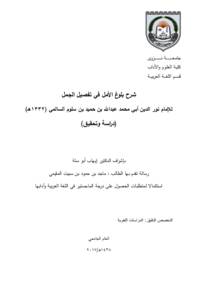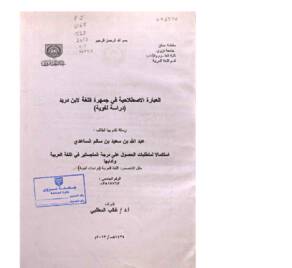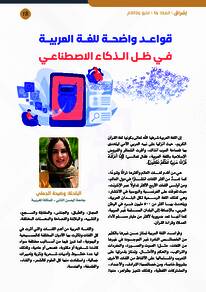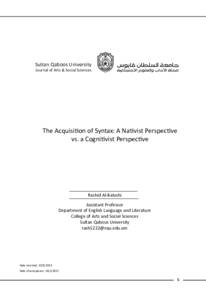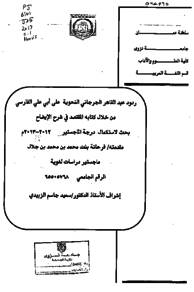وثيقة
شرح بلوغ الأمل في تفصيل الجمل للإمام نور الدين أبي محمد عبد الله بن حميد بن سلوم السالمي 1332 هـ : دراسة و تحقيق.
الناشر
جامعة نزوى
ميلادي
2017
اللغة
العربية
الموضوع
الملخص الإنجليزي
There are several aims to be achieved out of the value of the book being studied. First, it is an endeavor to publish Omani manuscripts on Arabic Language. Second, it aims at manifesting the production of one of the prominent scholars of Oman as his first book reveals signs of his pioneering, giving, concerns and ambition. Third, it aims at bringing out the scientific content cited.
This thesis falls into two sections; the first one is a study including an introduction and three chapters. The introduction is about the author in brief, his name and kinship, nickname, birth, part of his scholarly life, tutors, students, most important works, books, death and elegies.
The first chapter is about the book ( Al I'rab А'n Qawa'ed Al I'rab), written by Inb Hisham Al Ansari (761 of Higrah), which Imam Al Salmi used as basis for his book of this study. The section deals with six areas of research; the author. name of the book, its relation to other titles by the same author. comparing it to two other books by the author which carried its scientific content- the first is a brief one titled Al Qawa'ed Al Sughra and the second is rather elaboration titled Mughni Al Labib A'n Kutub Al A'areeb, effect of Al I'rab А'n Qawa'ed Al I'rab, and importance of this book with Imam Al Salmi .
The second chapter is about the book of the study in thirteen areas of research; its title inquiry, intended meaning of its title, its relation to the author, motives of composing the poetry and explaining it, time of writing the book, its order among books of Imam Al Salmi, its sources, its methodology and approach, its supporting examples, its terminology, its effect, tribute of the book, describing its manuscript, and some images of its pages.
The third chapter is around the scholarly character of Imam Al Salmi through his book. It includes three areas of research. First, the intellectual development of Imam Al Salmi between the two issues of his book in 1305 of Higrah and the second after 10 years in 1315 of Higrah, and the developments occurred on the poetry and its explanation. Second, elaboration and discussion
of Imam Al Salmi to the basis book (Al I'rab А'n Qawa'ed Al I'rab). Third, views of Imam Al Salmi and his discussion of other scholars views.
The second section is on the edited script including four topics; explaining of sentence and its types and grammar, phrases (adverbs of time and place, and nouns preceded by prepositions), explaining important words to the grammarian, and indicating some edited sentences
Below are the most important results concluded by the study: 1. The book of Al I'rab А'n Qawa'ed Al I'rab is the same book titled Al
Qawa'ed Al Kubra, and its brief is named Al Qawa'ed Al Sugra, or Al Nukat, or Nukat Yaseerah Muktasarah min Al I'rab A'n Qawa'ed Al I'rab or Nukat yaseerah Muktasarah min Qawa'ed Al I'rab or Nukat Ibn Hisham min Qawa'ed Al I'rab or Nubthat Al I'rab, or Mukhtasar Qawa'ed Al I'rab, or al Qawa'ed. The three books of Ibn Hisham Al Ansari Al I'rab A'n Qawa'ed Al I'rab and Al Qawa'ed Al Sugra and Mughni Al Labib . A'n Sharh Al A'areeb have the same common scientific content .
2 . Although Al Qawa'ed Al Sugra is a brief of Al I'rab А'n Qawa'ed Al I'rab, it contains entries which were not mentioned in the latter.
3.The title if the book being edited is Sharh Bolough Al Amal fi Tafseel Al Jumal without the word Mufradat which was mentioned in other versions.
5.The manuscript of Nathm Bolough Al Amal existing in the National Library in Cairo mentioned by Dr Ali Foudah Neil and attributed to Abdullah Hamad Al Salmi is the same meant poetry book in this editing. The name of the author was misspelled; the right spelling is Abdullah Humaid Al Salmi.
5 .Although the author of Nahdat al A'yan said that Imam Al Salmi wrote his book while he was 17 years old, two texts in his book contradict with that, and saying that composing the poetry of the book was before 1305 of Higrah is inconsistent with the texts.
6 .Imam Al Salmi issued his book twice in a period of 10 years, his poetry after had come across three stages which reflect the Imam's development in such a field.
7.the study documented the scripts from the first issue of the book and identified the changes as this book is an effort which demonstrates a stage of the developing scholarly intellect of Imam Al Salmi .
8 .Imam Al Salmi depended on three books which he frequently cited from; Al I'rab A'n Qawa'ed Al I'rab and its explanation: Mussel Al Tullab Ela Qawa'ed Al I'rab by Sheikh Khalid Al Azhari, and Mughni Al Labib A'n Sharh Al A'areeb
9.The first issue of the book included 10 narrations of the Prophet Muhammed
(PBUH). In his second issue Imam Al Salmi excluded four narrations which were described by scholars of Hadiths as doubtful. This reveals an aspect of his development in the science of Hadith, such fact is proved in 1315 of Higrah prior to his travel to pilgrimage in 1323. In addition, it is said that he became more knowledgeable in Hadith after he traveled to pilgrimage where he met scholars and the specialists on such science .
10.Imam Al Salmi did not follow the basis book exactly; he argued and adjusted order or else where he disagreed .
11 .In terms of Imam Al Salmi's opinions (12 opinions in total), sometimes he says 'it's likely' (6 times), and sometimes he mentions his opinion and that it differs from some scholars (3 times), and sometimes he says 'the truth is' (twice). He disagreed with Ibn Hisham in two problems, and disagreed the majority of Bisrits (scholars of Basrah) in one problem.
Perhaps this study is a beginning for a more comprehensive study of the linguistic works of Imam Al Salmi through all of his books, may his soul rest in peace
المجموعة
URL المصدر
الملخص العربي
هذه الدراسة تتعدد أهدافها المرجوة من قيمة الكتاب المعني بالدراسة والتحقيق ابتداء من كونها إحدى المحاولات لنشر المخطوطات العمانية في فن اللغة العربية، ومرورا بإظهار نتاج شخصية من كبار أعلام عمان، في أول مؤلف يحمل إرهاصات تفوقها وعطائها، وهمومها وطموحها، وانتهاء بمحاولة إخراج المادة العلمية التي تضمنها الكتاب إخراجا موثقا وقسمت الرسالة إلى قسمين، الأول: دراسة احتوت تمهيدا وثلاثة فصول، فالتمهيد حول التعريف بالمؤلف تعريفا مختصرا لشهرته، بذكر اسمه، ونسبه، وكنيته، ولقبه، وميلاده، وطرفا من حياته العلمية، وشيوخه، وتلاميذه، وأهم أعماله، ومؤلفاته، ووفاته، ورثائه. والفصل الأول بشأن الكتاب الذي جعله الإمام السالمي أصلا لكتابه - محل التحقيق - استقى منه مادته فنظمها ثم شرحها، وهو كتاب (الإعراب عن قواعد الإعراب) لابن هشام الأنصاري (761هـ)، وتناول هذا الفصل ستة مباحث حول مؤلفه، واسم الكتاب، وعلاقته بعناوين كتب للمؤلف نفسه، ومقارنته بكتابي المؤلف اللذين حملا مادته العلمية الأول منهما مختصر له وهو القواعد الصغرى والثاني تفصيل لها وبسط وهو مغني اللبيب عن كتب الأعاريب، وأثر كتاب الإعراب عن قواعد الإعراب، وأخيرا مكانة هذا الكتاب لدى الإمام السالمي.
والفصل الثاني فيه ذكر الكتاب المحقق، في ثلاثة عشر مبحثا: توثيق عنوانه، والمعنى المقصود منه، وتوثيق نسبته، ودوافع تأليف النظم وشرحه، وزمن تأليف الكتاب، وترتيبه بين مؤلفات الإمام السالمي، ومصادره، ومنهجه وأسلوبه، وشواهده، ومصطلحاته، وأثره، وتقريظ الكتاب، ووصف مخطوطاته، وصور لبعض أوراقها.
والفصل الثالث حول الشخصية العلمية للإمام السالمي من خلال كتابه، وتضمن ثلاثة مباحث: الأول عن التطور الفكري للإمام السالمي بين إصدارتي الكتاب (الإصدارة الأولى التي ألفها سنة 1305هـ، والإصدارة الثانية حين عودته لها بعد عشر سنوات أي سنة 1315هـ) ، والتطورات التي مر بها النظم وشرحه، والمبحث الثاني بين هذا الكتاب (شرح بلوغ الأمل في تفصيل الجمل) وبين أصله (الإعراب عن قواعد الإعراب)، تضمن زيادات الإمام السالمي ونقاشاته لأصله، والمبحث الثالث تضمن آراء الإمام السالمي ونقاشاته للعلماء.
وأما القسم الثاني فمحله النص المحقق، المتضمن أربعة أبواب الأول: في شرح الجملة وأقسامها وأحكامها، والثاني في شبه الجملة والمراد بها الظرف والجار والمجرور، والثالث في تفسير كلمات يحتاج إليها المعرب، والرابع: في الإشارة إلى عبارات منقحة.
ومن أهم النتائج التي خلصت إليها الدراسة: كتاب الإعراب عن قواعد الإعراب، هو الكتاب نفسه المسمى بالقواعد الكبرى، ومختصره هو الذي يطلق عليه: القواعد الصغرى، أو النكت، أو نكت يسيرة مختصرة من كتاب الإعراب عن قواعد الإعراب، أو نكت يسيرة مختصرة من قواعد الإعراب، أو نكت ابن هشام من قواعد الإعراب، أو نبذة الإعراب، أو مختصر قواعد الإعراب، أو القواعد ، وكتب ابن هشام الأنصاري الثلاثة (الإعراب عن قواعد الإعراب) ومختصره القواعد الصغری) و (مغني اللبيب عن كتب الأعاريب) تجمعها مادة علمية مشتركة. 2. القواعد الصغرى مختصر لكتاب الإعراب عن قواعد الإعراب، ومع ذلك اشتمل على أدوات لم ترد في الأخير. 3. عنوان الكتاب المحقق هو شرح بلوغ الأمل في تفصيل الجمل دون ورود لفظ المفردات خلافا لما تم في طبعات الكتاب والنظم. 4. مخطوط نظم بلوغ الأمل الموجود بالمكتبة الوطنية بالقاهرة الذي ذكره الدكتور علي فودة نیل ونسبه لعبدالله بن حمد السلمي هو نفسه النظم المقصود في هذا التحقيق، وإنما وقع السهو في كتابة اسم مؤلفه، وهو عبدالله بن حميد السالمي. 5. نص صاحب نهضة الأعيان على أن عمر الإمام السالمي حين تأليف الكتاب سبع عشرة سنة، ووردت إشارتان في كتابه تقتضيان خلاف ذلك، وأما القول بأن تأليف النظم كان قبل سنة 1305هـ فهو مخالف لظاهر النصوص . 6. أصدر الإمام السالمي كتابه مرتين بينهما عشر سنوات، ومر النظم بعد تأليفه بثلاث مراحل تعكس ترقي الإمام السالمي في هذا المجال. 7. أثبتت الدراسة النصوص من الإصدارة الأولى للكتاب ووثقت التغييرات ، لكونها جهدا يمثل مرحلة من تطورات الفكر العلمي لدى الإمام السالمي 8. اعتمد الإمام السالمي في شرحه على ثلاثة كتب نقل منها كثيرا مع الإشارة إليها، وهي: أصله الإعراب عن قواعد الإعراب، وشرحه: موصل الطلاب إلى قواعد الإعراب للشيخ خالد الأزهري، ومغني اللبيب عن كتب الأعاريب. 9. تضمنت الإصدارة الأولى للكتاب عشر روايات عن النبي - صلى الله عليه وسلم - استبعد الإمام السالمي منها في الإصدارة الثانية أربع روایات وهي التي ضعفها علماء الحديث ، مما يعكس جانبا من تطوره في علم الحديث ، ويبرهن على مكانته في هذا الفن سنة 1315هـ أي قبل سفره إلى الحج سنة 1323هـ ، إضافة إلى ما قيل بأن الإمام السالمي كان أوسع أفقا في علم الحديث بعد سفره ، واجتماعه هناك بعلماء الآفاق، ومن بينهم المتخصصون في علم الحديث. 10. لم يتابع الإمام السالمي أصله في جميع ما ذكر فخالفه واعترض عليه وعدل عما ذكره في الترتيب أو التعبير حين لم يتفق معه. 11. في آراء الإمام السالمي وترجيحاته - ومجموعها اثنا عشر رأيا -، مرة يعقب الرأي بقوله (على الأصح (وقع في ستة مواضع)، ومرة يذكر الرأي وأنه خلاف لبعض العلماء (وقع في ثلاثة مواضع)، ومرة يسبقه بقوله (والحق) (وقع في موضعين)، وقد خالف ابن هشام في مسألتين اثنتين، وخرج عن رأي جمهور البصريين في مسألة واحدة.
ولعل هذه الدراسة بداية الدراسة أشمل لآثار الإمام السالمي اللغوية من خلال تتبع سائر مؤلفاته - رحمه الله وطيب ثراه -.
والفصل الثاني فيه ذكر الكتاب المحقق، في ثلاثة عشر مبحثا: توثيق عنوانه، والمعنى المقصود منه، وتوثيق نسبته، ودوافع تأليف النظم وشرحه، وزمن تأليف الكتاب، وترتيبه بين مؤلفات الإمام السالمي، ومصادره، ومنهجه وأسلوبه، وشواهده، ومصطلحاته، وأثره، وتقريظ الكتاب، ووصف مخطوطاته، وصور لبعض أوراقها.
والفصل الثالث حول الشخصية العلمية للإمام السالمي من خلال كتابه، وتضمن ثلاثة مباحث: الأول عن التطور الفكري للإمام السالمي بين إصدارتي الكتاب (الإصدارة الأولى التي ألفها سنة 1305هـ، والإصدارة الثانية حين عودته لها بعد عشر سنوات أي سنة 1315هـ) ، والتطورات التي مر بها النظم وشرحه، والمبحث الثاني بين هذا الكتاب (شرح بلوغ الأمل في تفصيل الجمل) وبين أصله (الإعراب عن قواعد الإعراب)، تضمن زيادات الإمام السالمي ونقاشاته لأصله، والمبحث الثالث تضمن آراء الإمام السالمي ونقاشاته للعلماء.
وأما القسم الثاني فمحله النص المحقق، المتضمن أربعة أبواب الأول: في شرح الجملة وأقسامها وأحكامها، والثاني في شبه الجملة والمراد بها الظرف والجار والمجرور، والثالث في تفسير كلمات يحتاج إليها المعرب، والرابع: في الإشارة إلى عبارات منقحة.
ومن أهم النتائج التي خلصت إليها الدراسة: كتاب الإعراب عن قواعد الإعراب، هو الكتاب نفسه المسمى بالقواعد الكبرى، ومختصره هو الذي يطلق عليه: القواعد الصغرى، أو النكت، أو نكت يسيرة مختصرة من كتاب الإعراب عن قواعد الإعراب، أو نكت يسيرة مختصرة من قواعد الإعراب، أو نكت ابن هشام من قواعد الإعراب، أو نبذة الإعراب، أو مختصر قواعد الإعراب، أو القواعد ، وكتب ابن هشام الأنصاري الثلاثة (الإعراب عن قواعد الإعراب) ومختصره القواعد الصغری) و (مغني اللبيب عن كتب الأعاريب) تجمعها مادة علمية مشتركة. 2. القواعد الصغرى مختصر لكتاب الإعراب عن قواعد الإعراب، ومع ذلك اشتمل على أدوات لم ترد في الأخير. 3. عنوان الكتاب المحقق هو شرح بلوغ الأمل في تفصيل الجمل دون ورود لفظ المفردات خلافا لما تم في طبعات الكتاب والنظم. 4. مخطوط نظم بلوغ الأمل الموجود بالمكتبة الوطنية بالقاهرة الذي ذكره الدكتور علي فودة نیل ونسبه لعبدالله بن حمد السلمي هو نفسه النظم المقصود في هذا التحقيق، وإنما وقع السهو في كتابة اسم مؤلفه، وهو عبدالله بن حميد السالمي. 5. نص صاحب نهضة الأعيان على أن عمر الإمام السالمي حين تأليف الكتاب سبع عشرة سنة، ووردت إشارتان في كتابه تقتضيان خلاف ذلك، وأما القول بأن تأليف النظم كان قبل سنة 1305هـ فهو مخالف لظاهر النصوص . 6. أصدر الإمام السالمي كتابه مرتين بينهما عشر سنوات، ومر النظم بعد تأليفه بثلاث مراحل تعكس ترقي الإمام السالمي في هذا المجال. 7. أثبتت الدراسة النصوص من الإصدارة الأولى للكتاب ووثقت التغييرات ، لكونها جهدا يمثل مرحلة من تطورات الفكر العلمي لدى الإمام السالمي 8. اعتمد الإمام السالمي في شرحه على ثلاثة كتب نقل منها كثيرا مع الإشارة إليها، وهي: أصله الإعراب عن قواعد الإعراب، وشرحه: موصل الطلاب إلى قواعد الإعراب للشيخ خالد الأزهري، ومغني اللبيب عن كتب الأعاريب. 9. تضمنت الإصدارة الأولى للكتاب عشر روايات عن النبي - صلى الله عليه وسلم - استبعد الإمام السالمي منها في الإصدارة الثانية أربع روایات وهي التي ضعفها علماء الحديث ، مما يعكس جانبا من تطوره في علم الحديث ، ويبرهن على مكانته في هذا الفن سنة 1315هـ أي قبل سفره إلى الحج سنة 1323هـ ، إضافة إلى ما قيل بأن الإمام السالمي كان أوسع أفقا في علم الحديث بعد سفره ، واجتماعه هناك بعلماء الآفاق، ومن بينهم المتخصصون في علم الحديث. 10. لم يتابع الإمام السالمي أصله في جميع ما ذكر فخالفه واعترض عليه وعدل عما ذكره في الترتيب أو التعبير حين لم يتفق معه. 11. في آراء الإمام السالمي وترجيحاته - ومجموعها اثنا عشر رأيا -، مرة يعقب الرأي بقوله (على الأصح (وقع في ستة مواضع)، ومرة يذكر الرأي وأنه خلاف لبعض العلماء (وقع في ثلاثة مواضع)، ومرة يسبقه بقوله (والحق) (وقع في موضعين)، وقد خالف ابن هشام في مسألتين اثنتين، وخرج عن رأي جمهور البصريين في مسألة واحدة.
ولعل هذه الدراسة بداية الدراسة أشمل لآثار الإمام السالمي اللغوية من خلال تتبع سائر مؤلفاته - رحمه الله وطيب ثراه -.
قالب العنصر
الرسائل والأطروحات الجامعية

